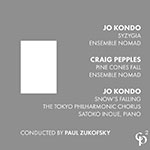
Syzygia
Ensemble Nomad
Craig Pepples
Pine Cones Fall
Ensemble Nomad
Jo Kondo
Snow's Falling
Tokyo Philharmonic Chorus
Satoko Inouye, piano
conducted by Paul Zukofsky

 |
Jo Kondo Syzygia Ensemble Nomad Craig Pepples Pine Cones Fall Ensemble Nomad Jo Kondo Snow's Falling Tokyo Philharmonic Chorus Satoko Inouye, piano conducted by Paul Zukofsky |
 |
These are the last recordings conducted by Paul Zukofsky before his death in 2017. The recording sessions took place in Tokyo in June 2016 with a program he selected. None of this could have been done without the kindness, dedication, and effort of Jo Kondo, who located players, studios, venues, attended rehearsals, and subsequently supervised the final editing when illness prevented PZ from doing so. The two beautiful Kondo works included here are a fitting tribute to the many years of friendship and collaboration between these two very special musicians. The following notes are based on sketches PZ left behind, consisting of an outline, citations, and specific emails he intended to cobble together. I have done my best to follow his intent but cannot change the fact that the notes are unfinished. (CP)
Busoni said it beautifully in his "Sketch of a New Aesthetic": The spirit of an art-work, the measure of emotion, of humanity, that is in it - these remain unchanged in value through changing years; the form which these three assumed, the manner of their expression, and the flavor of the epic which gave them birth, are transient, and age rapidly... But this is not true only in music. Compare Oliver Wendell Holmes (from the "Common Law"): The life of the law has not been logic: it has been experience. The felt necessities of the time, the prevalent moral and political theories, intuitions of public policy, avowed or unconscious, even the prejudices which judges share with their fellow-men, have had a good deal more to do than the syllogism in determining the rules by which men should be governed.... Just because someone is dressed differently does not mean that fundamental emotions have changed. Just because styles change on the outside does not mean that anything has changed underneath. Edmund Burke, Edward Gibbon, etc. etc. still ring true because underlying verities don't change. Or think of Schoenberg (in the new edition of "Style and Idea") who pointed out that stylistic differences between his "Suite in G" and his 12-tone music were unimportant. Aside from style or presentation, other quintessential musical dimensions are: pitch, line, color, and architecture (proportion/form). To expand: "Pitch" is the simplest. Physicists call it frequency. Musicians recognize it as the stuff that makes up harmony and counterpoint. On a global level, "pitch" is the element with which one can create programs that place Terry Riley's "in C" with Schubert's "Great" Symphony in C major, (thereby allowing one to explore BOREDOM); or more interestingly, a program such as the Beethoven "First", Stravinsky's "Symphony in C", and Mozart's "Jupiter", all nominally in C major, but each very distinct from the other. A more local version would be how pitches, and more importantly intervals, in the opening of Schoenberg's fourth quartet, expand and generate (see Babbitt's revelatory essay in "Words About Music"). Paul Klee's Pedagogical Sketchbook is a good starting point for "Line". "Line" can operate in music on a phrase level (i.e. just what is it in the timing or shaping when Callas sings a phrase in such a manner as to rip your heart out; but someone else makes the same phrase sound like a misshapen sausage cut with a dull, blunt, rusted knife?). "Line" is determined by timing and rhythm, but "line" also operates over very long time scales, i.e. the bass-line of a harmonic progression.1 Color is instrumentation or orchestration. Read your Koechlin, or Rimsky; even Berlioz-Strauss. Color can operate on the global level (what is the work scored for?); and it can operate on the local level (marvel at the celesta at the end of "Rosenkavalier"). Architecture is just that, i.e. how do you lay out the spaces, the "volumes", of a composition? Is the composition in many movements, or sections? What are the measure counts in Haydn minuets? If the work is not amenable to division into movements, how much time is spent on what seems to be a first section? Or a second section? How does the use of time compare across compositions of a certain composer? Between composers? And there are universalities, i.e. when one walks through some of the monuments of Angkor Wat and wonders why the layouts are so reminiscent of Chartres (and reading Henry Adams while walking through Angkor Wat is not the worst idea), so too there are universalities in how music gets "laid out".
Syzygia, from the definition of the New Century Dictionary: Yoked, paired. 1. In astronomy, the conjunction or opposition of a planet with the sun, or of any two heavenly bodies. 2. In ancient prosody, a group or combination of two feet. Ancient metricians varied in their use of this term. Some use it regularly for a dipody (or dipodic) measure. Others call a tautopody, or double foot, a dipody, but a combination of two different feet, a syzygy. Some, accordingly, giving the name syzygy to tetrasyllabic feet (regarded by them as composed of two disyllabic feet), speak of an iambic or trochaic line as measured by dipodies, but an Ionic line as measured by syzygies, that is, by single Ionics considered as combinations of trochees and pyrrhics. A peculiar use is the restriction of the term syzygy to compound feet of five or six syllables. 3. In algebra, a linear function in the variables. 4. In zoology, the conjunction of two organs or organisms by close adhesion and partial concrescence, without loss of their identity; also the thing so formed or the resulting conformation... A dialogue in Tokyo as the recordings were being made: PZ: In all the time spent on this, I have never asked you which In "Syzygia"; the metronome marks are mood changes; but the use of metronome marks for that purpose almost precludes the use of metric modulations, which would make the notation far simpler, and which I utilized in my conducting patterns without changing the barlines, which are to some extent phrases, but not always, since there is often conflict between the barlines, and events which clearly "start" things, but are not on the downbeat. Given a measure with the majority of instruments in triplets, and only two or three in regular eighth- notes, I beat the triplets, and turned the eighth notes into dotted eighth notes. It was far easier to get a musical shape in this way. There were also four or five places in which I wrote out various composite rhythms to help people better understand where they should come in. Preparing "Syzygia" was not easy. The root of the problem has to do with how we notate rhythms. The rhythmic notation system we presently use is more or less sufficient for fairly straightforward patterns in one tempo. The moment one tries to write the same rhythms at different speeds, without changing the metronome mark, one starts to have horrendous problems. One cannot always change the metronome mark if, especially as in this case, we have two or more tempi working simultaneously, with the result that fairly simple rhythms end up looking syncopated; or extremely disjunct, and distorted. Consider algebraic equations by analogy. Certain equations can be rewritten in many different ways, each rewrite emphasizing different aspects; some rewrites being very simple and obvious; others being ornate, bordering on opaque. I found Jo's chosen notation more opaque than usual, and it is not clear to me why he has chosen to do so for this piece; if his notation choice is arbitrary for this composition; if my decisions to re-notate certain equations violate some principle or understanding that I am missing; if I am not being faithful to the text because I am re-notating; and finally, I get back to St. Jerome's translation problem i.e. which is the better translation? The one which is (blindly, and rather stupidly) faithful to the exact word (in this case, the exact rhythmic notation); or is it a translation that "best conveys" (whatever that means) the underlying content, and thought, that gave rise to the original text (as if one ever knows what that is), even if the translation is not word-for-word correct.2 From Letter LVII of St Jerome: 'I have thought it right to embrace a labour which though not necessary for myself will prove useful to those who study. I have translated the noblest speeches of the two most eloquent of the Attic orators, the speeches which Æschines and Demosthenes delivered one against the other; but I have rendered them not as a translator but as an orator, keeping the sense but altering the form by adapting both the metaphors and the words to suit our own idiom. I have not deemed it necessary to render word for word but I have reproduced the general style and emphasis. I have not supposed myself bound to pay the words out one by one to the reader but only to give him an equivalent in value. [....] I shall be well satisfied if my rendering is found, as I trust it will be, true to this standard.' In all the recordings given here, and perhaps anywhere, there is a tug between absolute faithfulness to the score and "interpretation". Relevant to this are quotes from Stravinsky and Busoni that mark the extremes like Scylla and Charybdis: "The sin against the spirit of the work always begins with a sin against its letter and leads to the endless follies which an ever-flourishing literature in the worst taste does its best to sanction." - Stravinsky, Poetics of Music (Vintage), p.129 vs. "What the composer's inspiration necessarily loses through notation, his interpreter should restore by his own." - Busoni, Sketch of a New Esthetic of Music (Dover), p.84. but note that Stravinsky recorded "Symphony of Psalms" three times, and none of the tempos is the "same"; nor do they agree well with the score indications. ALSO, when I played "Pulcinella" with Stravinsky conducting, he exhorted the players to be "more Italian" (i.e. "shape the phrase"!!).3 How to balance? ...all this is the art of rhetoric (or as Adam Smith would spell it, rhetorick), defined by the New Century Dictionary as: 'that art which consists in a systematic use of the technical means of influencing the minds, imaginations, emotions, and actions of others by the use of language.' But is not what musicians do that very same art of rhetorick, except that we do not have words to help convey meaning (but then neither do we have the misunderstandings and misinterpretations that arise from those same words)?4
[The histogram is included in CD liner notes.] The difficulties in this piece are intonation and decay, since each note of almost every chord has a different length. Questions also arose as to whether grace notes should be dance-like or more melodic; phrase lengths are also curious, often extending across silence in a kind of enjambment. CP supplied the T'ang poem of Wei Ying Wu that gives the piece its name: 壞君屬秋夜,散步詠涼天。
Missing you belongs to autumn nights; [from an email exchange of Feb 12, 2016: CP: "Cold skies" is some ancient song and "Refined Person" is some sort of formal title as in "Your Excellency" PZ: pls be aware that Gooooooooogle translates this as: Huai Jun genus autumn, walking chant cold days.
雪が降つてゐる ∙∙∙∙
雪が降つてゐる、 Snow's falling …..
Snow is falling, PZ, April-November 2016
Flute, Dogen Kinowaki
Shakuhachi, Reison Kuroda
All conducted by Paul Zukofsky Total Time: 47:15
Jo Kondo SYZYGIA* *Publisher: University of York Music Press All recordings were made at Avaco Creative Studio, Tokyo, Japan; 'Syzygia' and 'Pine Cones Fall' were recorded on June 9, 2016 and 'Snow's Falling' on June 15, 2016. Recording Engineer: Yukio Kojima; Mastering Engineer and Editing: Jun Kawanami. CP2 125
|